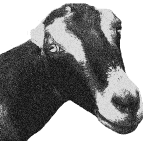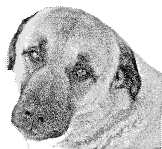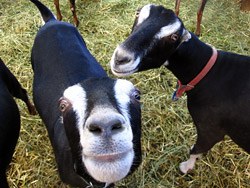






Picture (looks)!
--Shape: We try to breed a doe who is wedge shaped when viewed from the side or top (long rear rib) and wider at the rump than at the withers. We also like a doe who is quite proportionate having the same length canon bone, as stifle, as rump (both from side to side and hips to pins) etc. We like the rump angle to be about 20% to 25%. We like the rear legs to allow for a straight line (ruler or stick) to be dropped from the pins through the hock and dew claw and hoof. We like the front leg to be right under the withers with a ruler to be dropped straight down the front leg through the hoof. We like to see the brisket when viewing from the side. We want the back to be intermediate in length and relatively flat rising into the withers. We want a doe who is 30”-34” at the withers when mature, but not bigger nor much smaller.
--Head: They must have a gopher ears and we have never had anything but that. We also try to breed for a slightly dished face, with a bit of a wedge in the head as well with a slightly wider forehead then nostrils (even though the breed standard calls for a straight face), the eyes should dominate the head. We are not as successful at getting this all the time. A deep jaw and wide nostrils are very important in our breeding program as we think it relates to production performance. (A side note you can have a deep jaw and wide nostrils with any type of nose profile.)
Performance!
We are trying to breed does who will milk 3,000 pounds with more than 120 pounds for fat and 100 pounds protein with a flat lactation milking no less then 8-10 pounds towards the end of their lactations when mature. (We are having some success with this, as now most does in the current herd have an ME of 3,000 or over). The milk MUST TASTE GOOD!
We would like does who have a long breeding season giving us milk year around. We freshen does from January to June, but would like to move a few to December and maybe extend a few does to July, for more winter milk. We are now trying to develop some does to milk 2 years without re-freshening as this is a useful trait for commercial dairies without a market for thier kids.
The does must be easy to milk by hand from the side and by machine from the rear. The teats have to be of a size, shape and placement to accommodate this. We would rather have a bigger teat than smaller for this reason and sometimes keep does whose teats tend to be larger then called for by the ideal.
They must have a pleasant disposition; eccentric is fine just not mean or poor behavior in the milk room.
Their feet must be easy to trim and maintain.
The does must thrive on our management without special diets, special additives, special grain, etc. They need to do well on feed store grain, stored alfalfa, etc. They do get vaccinations, vitamins and sunflower seeds in addition to grain and alfalfa. The kids need to be able to be hand raised on twice daily feedings from a lam-bar and be fully weaned by 12 weeks and growthy without being stuffed full of grain (an expense we don't want).
We like does who are long lived, productive (over 20,000#’s) and have 20 or more kids in their lifetime.
Preferences!
In addition to the above goals, that are more toward requirements, we would prefer that the does be short coated (the breed standard does call for a short, fine and glossy coat), black and tan (light beige to dark red face stripes and leggings) in color. We have no preference with regard to spots, belts or roaning and many does have these. We also prefer lamanchas who are dark eyed, without wattles, score 90 or better on appraisal (all mature does in the current herd do appraise 90 or better and have an "E" in mammary) and win in the show ring (please notice this is a preference not a requirement). We do occasionally keep a doe who meets our other requirements and never finishes her GCH.
All in all we breed LaManchas for us—for our ease of management and for us to look at 365 days a year. If a judge likes what we breed that is great! If he/she doesn’t we are disappointed, but we are not going to race home and change years of breeding. After 45 years of doing this we have a pretty good idea of what type of LaMancha we are trying to breed. Success for us now, is to get every doe to meet our goals---generation after generation! We have yet to see the perfect LaMancha and certainly haven’t bred her—yet!
Thanks for reading,
Don and Judi (With some additions from John and Chris)
Updated 2/5/2023
Management Ease is a Must!